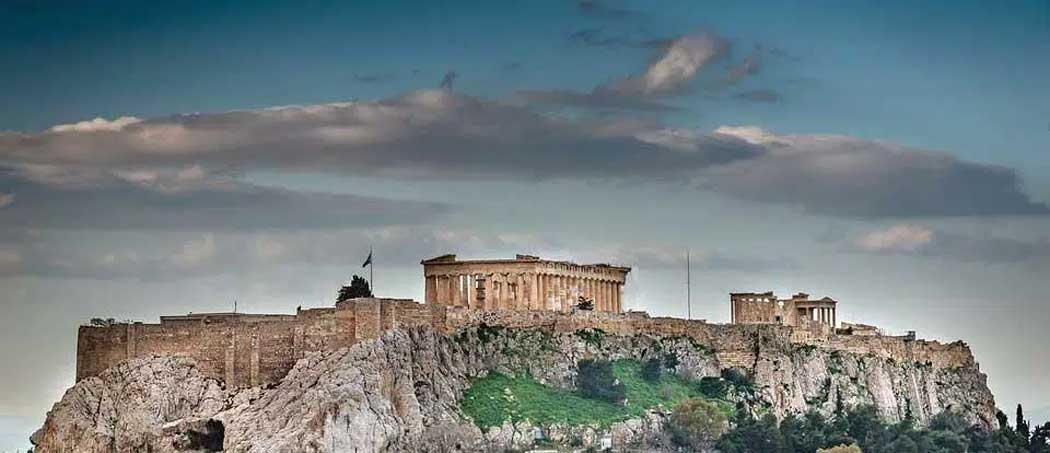Brief History of Athens Greece
Athens was named according to the mythology of Greece from competition that the goddess Athena had with Poseidon about who will become protector of the city. The myth says that Poseidon gave a spring with sea water whilst Athena offered an olive tree as she touched the ground of the sacred rock of the Acropolis.
The people of Athens choose Athena as their protector and so the city was named after the goddess of wisdom. The myth is symbolic but the two Gods symbolising the strength of Athens as a city of wisdom and as a sea power.
The first settlement of Athens 3000 BC was situated on the rock of Acropolis. The history of Athens is inextricably linked with the history of this sacred rock. As the archaeological investigations showed, the ancient inhabitants of the Stone Age were settled in the caves of the northern side of the Acropolis. When there was danger, the inhabitants sought refuge on the top of the fortress.
Cecrops and Theseus
An important change in the political and social organization of Attica took place around the 15th century BC by Cecrops, who is considered the hero-founder of Athens and the creator of the Attic culture. According to tradition, as given to us by ancient authors, he divided the inhabitants into 12 federations, but he reigned in one of them (Athens), which he built on the Acropolis and called it Cecropia.
The Acropolis of Athens was a typical Mycenaean site and included the characteristic functions of a Mycenaean state: political and religious, these two functions were concentrated in the same person, who was king and at the same time high priest. Thus, within the walled area were the king’s palaces, placed on the highest point of the rock, between today’s Parthenon and the Erechtheion, the administrative buildings, the main sanctuaries and the residences of the nobles.
The changes that took place in the Mycenaean era were attributed by the ancients to the mythical hero and king of Athens, Theseus. These changes concern the organization of the state on new bases, with the unification of all the settlements of Attica under a single administration, common gods and a common cult center.
Development and Colonies
The smooth and undisturbed life of the city, at this very time, was the cause of population attraction from the rest of troubled Greece, at the same time Athens began the establishment of colonies in Asia Minor and elsewhere, as well as the development of craft and trade. While, previously, the city consisted basically of the Acropolis area, now, with the concentration of a new population, the city expands around the Acropolis and especially towards the northern side.
Over time, the Agora of the city gathered all public functions and formed the core of the settlement, where citizens gathered for their affairs and where the most important events took place and all important state decisions were taken.
It was gradually formed around a square dedicated to public life and was the seat of justice and administration, (at the same time it was a place for sports demonstrations and dramatic competitions.
The Acropolis was dedicated to religious worship, especially to the worship of Athena. Many temples and sanctuaries were also built in the area of the Agora, but this did not mean that the religious importance of the Acropolis diminished.
The most important building of the Agora was the Rectory which simultaneously housed political and religious functions. Inside this building was kept the sacred unquenchable flame of the hearth of the city. The administrative buildings were adjacent to each other, creating in a way an administrative center, as we would characterize it with modern terminology.
The sanctuaries and altars were mainly concentrated on the western slopes of the Acropolis. all kinds of changes observed in Athens at the beginning of 600 BC are basically due to Solon, whose legislation clearly influenced the Fortune of Athens.
When Eleusis, a rival of Athens until then, was also annexed to the Athenian state, the power of Athens was consolidated, the needs grew and Solon put into practice the foundations for the creation of a great urban planning and architectural project, the new Agora of the city .
Athens in the Antiquity
Peisistratos
In 560 BCE Peisistratos, with the help of the people, takes power and establishes a tyranny. In the era of his tyranny, the foundations were laid for the creation of the great naval and commercial state of Athens, and the construction and beautification of the Agora and the city also continued. After the tyranny had given all it had to give to the people, it collapsed.
Cleisthenes
Cleisthenes, who was elected nominal ruler in 508-507 BCE, accomplishes what Solon had planned, the establishment of the republic. He turned the Solonian division into 4 tribes into 10 new tribes.
The democracy continues its development, reaching its peak in the era of Pericles (460-429 BC), who gave all the power to the Church of the municipality. The power was supplemented by the Parliament and the court of Iliaia.
The development of democracy is characterized by the limitation of the power of the lords and the establishment of the new institution of generals.
The real political power went into the hands of the generals, who undertook, in addition to the command of the army, the finances of the state, its relations with the other city-states, the security of the city, etc.
While the rulers were chosen by lot, as if chosen by the gods, the generals were chosen for new, more practical needs.
Later came to power the nobles (wealthy landowners). The nobles ruled Athens by their consul the Supreme Court (Arios Pagos), from this consul where elected the 9 rulers of Athens . During this time was existed the assembly of the Athenian citizens (Ecclesia of Demos) but during this period did’t had the power that had later with the lows of Solon.
The main characteristics of Athens are quite different from those of Sparta, because despite the existence of laws and the state, the concept of the individual-citizen was important. The main concern of the legislators was to strengthen the national conscience and to protect the democratic state. At the same time, however, local freedom was encouraged and each municipality had the opportunity to decide on its local affairs, but the state intervened when it deemed it necessary.
Each municipality sent its representatives to the city which was the cohesive web of the state. The national consciousness was strengthened with the creation of several festivities but also public works that increased the sense of pride of the inhabitants but also prevented social explosions, by employing to do those works the unemployed and the poor Athenians
Culture of Ancient Athens
At the same time, the existence of laws that favored equality and the creation of a humanitarian culture, enabled the Athenian citizens to emerge and evolve. This fact was unthinkable for cultures outside Greece (where everything in a person’s life was predetermined and given) and will be a significant noticeable difference of Greek culture from the rest. The Athenians were always proud to belong to the Ionians, a race that had lived in the area for a long time. The creation of the city of Athens is largely due to Theseus and the name of the Goddess Athena who prevailed over Poseidon. Nevertheless, the cities of Ionia have the avant-garde in Greece followed by Athens .
The gradual rise of Athens will begin in the middle of the 7th century BC. As in most cities, so in Athens there were significant problems, with many people finding it difficult to cope with their obligations resulting in the conversion of several of them into slaves. While the bourgeoisie is unhappy, since although it participates in the financial burdens of the state it does not have the corresponding participation in the political events… Although there will be reactions and unrest here, it will be easier than elsewhere to move from the absolute power of the king to the oligarchic and from there in a democratic regime. So throughout the 6th century there will be laws that will protect the weak but also a gradual transition to democracy. The most important legislators were Solon in the twilight and Cleisthenes in the twilight of the sixth century BC.
The role of the women in Ancient Athens
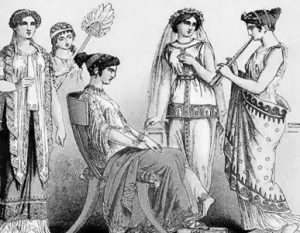
After the the period of colonisation and expansion of trade, many citizens of Athens became rich and wealthy from the trade and shipping, and they wished to participate in the administration of the state, while from the other hand the lower classes of the city where facing poverty. This fact resulted riots between the poor who wanted land and new lows with more social justice and the nobles that wanted to keep their power and authority.
Those riots tried to exploit the ambitious Cylon aiming to become a tyrant, but he failed. His movement stayed in history as ‘Cylonian Curse‘. After this , the nobles tasked Drakon to write new laws in response to peoples demand. But the laws of Dracon were too hard and peremptory and thus disappointed the Athenians.
As the laws of Dracon did not meet the expectations of the people of Athens who they tasked Solon, which was considered as a very wise man, to write new laws.
Solon gave back the debts of the citizens and let free all those who had been slaves from their debts. That law, because released the people of Athens from a very heavy burden, was named ‘seisachtheia’
Solon split the Athenians into four classes, depending on their income. Archons (rulers) had the right to become only the rich. But, Solon strengthened politically and the poor, because he gave the great strength to the Ecclesia of Demos, namely, the assembly of citizens. The assembly decided on all major issues and was voting the laws which were prepared by the House of the four hundred. Solon founded the large peoples court, the Iliaia. Those where the first steps towards democracy.
Golden age of Athens
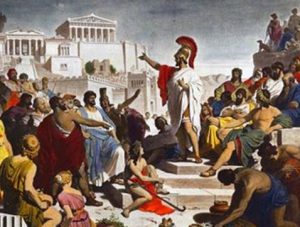
The economic power of the state was the condition for the development of the arts and the intellectual movement, in such a way that Athens became the center, not only of Greece, but also of the entire ancient world.
The Acropolis, on which a complex of religious buildings was built at the time of Pericles, was the symbol of the power of Athens as a city-state against the other allied cities.
The colossal effort made by the Athenians to reform the Acropolis proves the enormous importance they attached to religion – the city’s biggest celebration, the Panathenaia, in its final and most important phase, took place on the Acropolis
Peloponnesian War and Decline
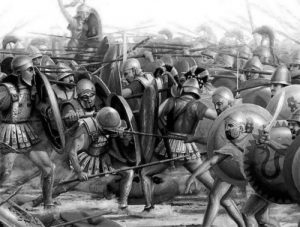
The Athenians were forced to tear down the walls of their city. After their defeat and throughout 4 BC. h. the Athenians tried in every way to regain their lost power. But Athens never again became the powerful state it was at the time of Pericles.
Thus the terrain was quite difficult and Philip of Macedonia did not encounter any particular difficulties. Philip and Alexander treated Athens with special favor in relation to the other Greek cities.
Athens during the Hellenistic times
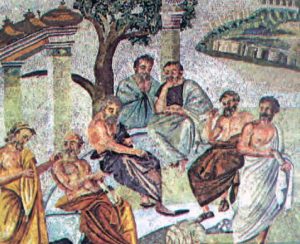
In 86 BC it knows the first great looting of its monuments and the massacre of its population by the Roman forces of the military and political Sulla, which results in the submission of the city to the Romans. But then some Roman emperors of the first post-Christian century -specifically Trajan, Hadrian, Antoninus and Marcus Aurelius-, rulers who had respect for classical culture, benefited Athens, which experienced a new period of prosperity.
As for its Christianization, the apostle Paul visited it in 52 AD. and, while at first his preaching was mocked, afterwards the Athenians were converted to the new religion thanks to Dionysius the Areopagite who founded the Christian community of Athens.
Roman period of Athens
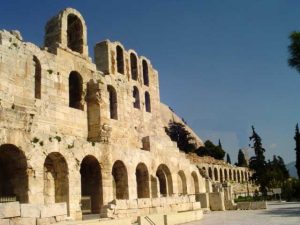
In 86 BC Athens, which was supported by the Athenians and the army of Mithridates, is occupied by Sulla, who, after during the siege, destroyed the sanctuaries, the groves and the philosophical schools that were outside the city, entering Athens he burned and destroyed most buildings. Piraeus also suffered the same disasters.
The Roman conquest of Greece, which began in 146 BC, does not seem to have directly affected the political life of Athens, of course the city-state was a memory and Athens had lost its old independence and especially its sovereignty.
During the first phase of Roman rule, the Athenians tried to play a political role in Roman affairs, in order to gain privileges and save what was left of their democratic state. The Roman power, however, cut off any attempt of external influence of Athens, to the point that at the beginning of the 1st century BC. , the once mighty city-state to limit its political activities to local government.
While Athens is now a vassal city, it is saved from the treatment other cities suffered by the Romans, its old cultural values that radiate and even observe Roman culture. Athens is still an intellectual center, with schools of a university nature, which were attended by young people from all over the empire and even many Roman generals.
A special sympathy of the Roman emperors for the Classical culture favored the city in many ways. The city during the whole Roman period shows an appearance of prosperity, thanks to the favors of Roman emperors or nobles, who replaced the beneficent kings of the East.
However, the contribution of the Romans to the development of Athens is not limited to the construction of new buildings or the expansion of the city. Old problems, such as water supply, were solved on Hadrian with the construction of aqueducts. At the same time, the sewers are filled and new roads are built or old roads are paved.
Hadrian’s Athens
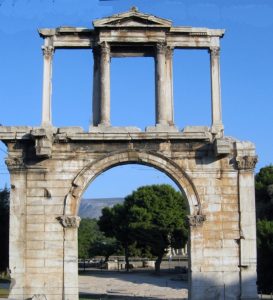
The new quarter was designated a new city and was distinguished from the old one by an arch built by the Athenians and dedicated to the emperor Hadrian. Adrianople (“new Athens” of Hadrian) was a continuation of the old city to the E and SE, after part of the ancient Themistoclean wall was demolished.
We assume that the direction was chosen because there were free spaces in that direction and because in this way the city was in direct contact with the green areas of Ilissos. Because the area was intended for wealthy Athenians and mainly Romans who had settled in the city and because it was the first time organized expansion was taking place, the plan included plots of land where mansions were built, as well as recreational areas such as fountains and fountains.
Athens of the 3rd century AD
As mentioned above, the city remained unfortified for more than three centuries. The fact that the walls were not even needed during this period is due to the power and supremacy of the Roman Empire, vis-à-vis the entire Mediterranean world (Pax Romana).
Later, however, in the 3rd century AD, the danger of the barbarian tribes of central Europe, which began to threaten the Roman Empire, convinced the emperor Valerian to fortify Athens and other Greek cities.
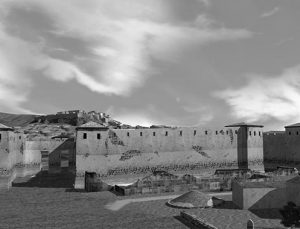
The only addition that was made was the temple of Rome and Augustus to the east of the Parthenon. The most important change of the Roman period is the implementation of an important intervention plan in the area of the city.
Until this time, the essential operations were carried out in the Agora area itself. With the construction of the new Roman Agora, which brought together a large part of the commercial operation, the library of Hadrian and the other neighboring buildings, a new pole of attraction was created, which decisively reduced for the first time the intensity of the movement of the Agora of Kerameikos.
However, the short distance between the two poles and the easy movement from one to the other, with two roads that connected Hadrian’s library and the Roman Agora with the Agora of Kerameikos, creates a new urbanistic view of Athens.
Most of the buildings that had housed ecclesiastical functions in earlier periods were saved from Sulla’s destruction, and some of those destroyed were later restored by the Romans themselves. Thus, while the political power of Athens had disappeared, whatever state functions could still be exercised, even if in a rudimentary form, were housed in the old buildings, thus maintaining a superficial glamour.
The religious buildings increased significantly in number and area, mainly in the area of the Agora of Kerameikos.
Athens, which for centuries had followed the fortunes of the Roman Empire, was about to witness its downfall. The impossibility of restoring the destroyed city, after the Heroulian raid in 267 AD, also reflects the economic “decline” of the empire and subsequently of Athens.
The basic changes in the urban organization of the city, which followed the disaster, are among the most important that Athens suffered. The main feature of the change is the limitation of the area of the city within a small wall, which left out the square of the Agora of Kerameikos.
The life of the city, after its temporary limitation to the small late Roman wall, develops again and functions smoothly for about two centuries. The operation of the philosophical schools of Athens, which are also one of the main economic resources, continues, giving the city the possibility of existence and development.
Athens during the reign of Byzantium
In 267 AD the Gothic tribe of the Herouls invaded Athens and set fire to the entire city with the exception – fortunately – of the Acropolis. This was also the second disaster in the history of the city. Until the 4th century AD, however, Athens had not experienced a particular decline, despite the two disasters that had preceded it. This is demonstrated by the assistance provided by the Athenian fleet to Constantine the Great against his opponents.
Thus, when he became Emperor in 324, he rewarded the Athenians by exempting their teachers from direct taxes. This fact shows that Athens maintained its prestige in the educational field. However, in 396 there is evidence of an invasion by the Goths.
As for the Parthenon, around 480 it was converted into a Christian temple dedicated to Panagia Athiniotissa. This cult replaced that of Pallas Athena. It is worth noting that, as the years passed, Athens gradually turned into an important place of pilgrimage to the Virgin Mary. Many sources of travelers testify to this. In fact, Basil the Bulgar-slayer himself had visited Athens and the Parthenon for a pilgrimage.
The abolition of the ancient religion of Athens
The ordinances which followed against the ancient religion as the centuries progressed, i.e. the banning of all public pagan ceremonies or the banning of the Olympic games, were not indiscriminately applied in Athens, which still had a strong pagan tradition. In the middle of the 5th century, however, the chryselephantine statue of Athena, after being stripped of everything valuable it had, was moved to Constantinople, from where it mysteriously disappeared in the 10th century. In the same period, the destruction of the Diverse Lodge is witnessed. However, the decisive blow to the city’s educational tradition was given by Emperor Justinian’s decision to close the city’s philosophical school. The last national teachers, after this, fled to the court of the Persian king Chosroes.
Raids during the middle ages
More raids against the city were recorded in 580 by the Slavs, in 1040 by the Varangians as well as by the Normans of Roger II in 1147 and by the Saracens in 1182, to come to the invasion in 1203 by Leo Sgourou, the Byzantine lord of Nafplio, who had rebelled against the emperor Alexios III Angelos.
In this situation Athens was found by the invasion of the Frankish crusaders into the territories of the Byzantine Empire and the fall of Constantinople in 1204. Athens was awarded to Boniface Momferatikos, the leader of the crusade, who expelled Leo Sgouros and ceded Athens as a fief. to the Burgundians under the house of de la Roche. Thus the Duchy of Athens and Thebes was founded. During this period the lords of the city often clashed heavily with the Frankish rulers of Evia. As for the fortifications, they built a tower on the Acropolis, called the Tower of the Propylae, and one in Thebes (also called the Tower of Santomeris), where the rulers of the Duchy resided. The Roman Catholic Church in Athens was also established, but this had little effect on the population, as did the contacts of the Franks with the Greeks.
The Burgundians ruled the city until 1311, when in the Battle of Kopaida or Battle of Almyros the invaders from the so-called Catalan Company defeated the Burgundians. The Catalan Company had been founded by Roger de Flor in the early 14th century and was made up of mercenary adventurers.
When they were out of work and therefore without resources to live on, they turned to the Byzantine emperor Andronikos II who hired them to fight the Turks. But he defaulted on his financial obligations to them, as a result of which these adventurers plundered the Balkans. So after they defeated the Burgundians and overthrew the Duchy, they horribly plundered Thebes. Not even Athens was spared from their fury, since the Catalans destroyed the Eleonas in Colonos and completely demolished the district to the east of the Acropolis.
Frankish period
The year 1205 AD, with the conquest of the Franks, is the limit for a new period. A significant urban change is observed in the city. The Frankish period of Athens, characterized by continuous changes of conquerors, ends with the conquest by the Turks in 1456-1458 AD.
The Turks who did not conquer Athens by force, like the Franks, give a lot of privileges to the Athenians and help to develop the city. The post-Roman wall is slowly being destroyed and the city, receiving new residents, expands far beyond it.
The next chronological period in the history of Athens can be placed in 1687, when the Venetians, under the leadership of Morozini, attacked the city and caused significant destruction.
The event of the Venetian attack and its consequences mark the beginning of a second period of Turkish rule in Athens. The most important works of the Franks concern the fortifications of the city.
In the middle of the 13th century, the fortifications of the Acropolis were strengthened, and in particular a very strong wall was built at the entrance, in which the so-called Bele gate (built by Valerian at the end of the 3rd century AD) was incorporated
At the same time, two towers were built on the Acropolis, one next to the temple of Niki and the other to the east of the rock. Towards the end of the 14th century, the city walls were also strengthened by the Florentines.
The functions on the Acropolis are very important in this period and we can say that the area was a second center. The area, mainly of the Propylaea with the palaces and the guard, was the preeminent administrative center and the Parthenon (temple of the Virgin Mary) with the other religious buildings was the religious center of the Latin part of the population.
Occupation by the Ottomans
This last period of Florentine rule was from 1388 to 1456, when the city succumbed to the Ottoman invasion after a siege of the Acropolis, a siege that lasted almost two years. Then Muhammad visited the city. Some even argue that the name of the area Patisia was given because of Patishah Mohammed (title for the sultan) who visited the city at the time. In 1458 the Parthenon was converted into a mosque. A minaret was built in the south-west corner of the Parthenon, all Christian symbols were removed from its interior and the Christian period hagiographies were plastered over.
Although the monument suffered several damages during the siege of 1458 and from the previous campaigns, it would still be in a much better condition today and with its roof intact if in 1687, during the sixth Venetian-Turkish war, the Venetian commander-in-chief Morosini, later doge of the Peaceful Republic, did not decide to besiege Athens and the Acropolis. Then a shell fell directly on the roof of the Parthenon, which the Ottomans during the siege used as a powder store, and completely destroyed it. In addition, Morosini, who eventually captured Athens, but left it almost immediately because he could not hold it, also looted several sculptures from the monument
Liberation of Athens 1822.
Since then, after this ill-fated Venetian attempt to capture the city, Athens would remain under Ottoman occupation until its liberation in 1822 during the Greek Revolution. As for the Parthenon, after serving as a temple of three religions over the centuries, it eventually became a visitable archaeological site.
Athens becomes the Capital of Greece
In 1834 Athens was proclaimed the capital of the Kingdom of Greece, which had recently become independent from the Ottoman Empire. From the Turks, Athens had been conquered in 1456: the Parthenon had thus become a mosque and the inhabitants, at the end of the eighteenth century, had been reduced to 12,000. In 1827, during the war of independence, the city was completely destroyed.
The monarchy that ascended the throne of Greece (1833) was of German origin and wanted to make Athens a capital worthy of its past (ancient Athens) and its significance in the history of humanity. A generation of European intellectuals had fought for the freedom of Hellas, in the name of ancient Greek culture: the new capital had to become its symbol again.
The significance of Athens in the History of the Greek nation, lies in its role as the cradle of democracy, its cultural and intellectual achievements, its pivotal role in historical conflicts, and its lasting influence on Western civilization.
Legacy of Athens
The legacy of Athens, the capital city of Greece, has had a profound and enduring impact on the world. Athens is often referred to as the cradle of Western civilization due to its significant contributions in various fields such as philosophy, democracy, literature, arts, and more.
This legacy has permeated Western culture and beyond, leaving an indelible mark on various aspects of human thought, creativity, governance, and societal value
Democracy
Athens is renowned for establishing one of the earliest forms of democracy in the ancient world. In the 5th century BCE, the city-state introduced a democratic system of governance that allowed citizens to participate in decision-making. While limited to a portion of the population, this concept of direct democracy laid the foundation for modern democratic systems.
Philosophy
Athens was home to some of history’s most influential philosophers, including Socrates, Plato, and Aristotle. These thinkers explored fundamental questions about existence, ethics, politics, and knowledge. Their ideas have profoundly shaped Western philosophy and continue to influence contemporary thought.
Literature and Drama
Athenian playwrights like Aeschylus, Sophocles, and Euripides contributed to the development of Greek tragedy and comedy. Their works explored themes of human nature, morality, and the gods, leaving a lasting impact on literature and theater worldwide.
Architecture and Art
Athens is renowned for its architectural achievements, with the iconic Parthenon atop the Acropolis being a prime example. This Doric temple dedicated to the goddess Athena is a symbol of classical Greek architecture and a testament to the city’s artistic and engineering prowess.
Olympic Games
The ancient Olympic Games, held in Olympia, Greece, were an integral part of Athenian culture. Athens revived the Olympic Games in 1896, contributing to the establishment of the modern Olympic movement.
Rhetoric and Oratory
Athens played a crucial role in the development of rhetoric and public speaking. Prominent orators like Pericles delivered influential speeches that shaped political discourse and communication techniques.
Historical Records
The historian Herodotus, often referred to as the “Father of History,” and Thucydides, known for his detailed account of the Peloponnesian War, were Athenian scholars who laid the groundwork for historical writing.
Legacy of Language
The Greek language, including its alphabet, has had a profound influence on Western languages. Many scientific, philosophical, and medical terms have their origins in Greek.
Aesthetics and Beauty
Athenian ideals of beauty and aesthetics influenced art, architecture, and philosophy throughout history. Concepts like symmetry, proportion, and harmony continue to impact various artistic disciplines.
Education and Academia
Athens’ emphasis on education and intellectual pursuits led to the establishment of schools and academies. This tradition of learning contributed to the development of academic institutions in subsequent centuries.
